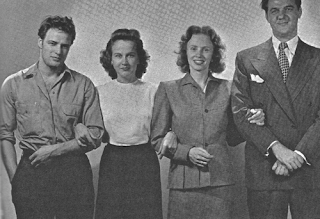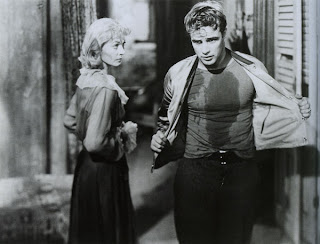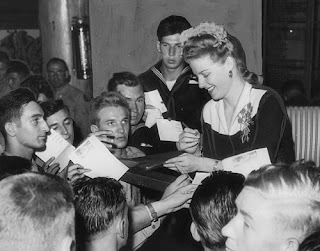 Rachel Weisz as Blanche DuBois, with Ruth Wilson and Elliot Cowan at Donmar, London (2009)
Rachel Weisz as Blanche DuBois, with Ruth Wilson and Elliot Cowan at Donmar, London (2009) Yesterday it was the 64th Anniversary of the opening of Tennessee Williams's play "A Streetcar Named Desire" on Broadway (on 3rd December 1947), which later was directed by Elia Kazan in its film version in 1951, with a screenplay by Tennessee Williams and Oscar Saul.
Yesterday it was the 64th Anniversary of the opening of Tennessee Williams's play "A Streetcar Named Desire" on Broadway (on 3rd December 1947), which later was directed by Elia Kazan in its film version in 1951, with a screenplay by Tennessee Williams and Oscar Saul. Marlon Brando, Kim Hunter, Jessica Tandy and Karl Malden during the 1948 stage production of "A Streetcar Named Desire"
Marlon Brando, Kim Hunter, Jessica Tandy and Karl Malden during the 1948 stage production of "A Streetcar Named Desire" Marlon Brando and Vivien Leigh as Stanley Kowalski and Blanche DuBois in "A Streetcar Named Desire" (1951) directed by Elia Kazan
Marlon Brando and Vivien Leigh as Stanley Kowalski and Blanche DuBois in "A Streetcar Named Desire" (1951) directed by Elia Kazan Ellen Dowling and Nancy Pride suggested that directors should use the ambiguity evident in the play to their advantage: they can alter the performance to match the strengths and weaknesses of their actors, where Blanche and Stanley alternate roles of protagonist and antagonist. John Timpane, also in Schlueter’s 'Feminist Rereadings', posits that reading 'A Streetcar Named Desire' from a feminist perspective actually heightens the ambiguity, deconstructing their responses. As Timpane notes, ambiguity is not necessarily an artistic failure and may even be intentional: “in a way, ambiguity is a hedge against annihilation” [Schlueter] -CRITICISM ON A STREETCAR NAMED DESIRE, (1947-2003) by JOHN S. BAK
Ellen Dowling and Nancy Pride suggested that directors should use the ambiguity evident in the play to their advantage: they can alter the performance to match the strengths and weaknesses of their actors, where Blanche and Stanley alternate roles of protagonist and antagonist. John Timpane, also in Schlueter’s 'Feminist Rereadings', posits that reading 'A Streetcar Named Desire' from a feminist perspective actually heightens the ambiguity, deconstructing their responses. As Timpane notes, ambiguity is not necessarily an artistic failure and may even be intentional: “in a way, ambiguity is a hedge against annihilation” [Schlueter] -CRITICISM ON A STREETCAR NAMED DESIRE, (1947-2003) by JOHN S. BAK Jessica Tandy was originally slated to play Blanche, after creating the role on Broadway. The role was given to Vivien Leigh (after Olivia de Havilland refused it) because she had more box-office appeal.
Jessica Tandy was originally slated to play Blanche, after creating the role on Broadway. The role was given to Vivien Leigh (after Olivia de Havilland refused it) because she had more box-office appeal. John Garfield turned down the role of Stanley Kowalski because he didn't want to be overshadowed by the female lead.
John Garfield turned down the role of Stanley Kowalski because he didn't want to be overshadowed by the female lead. Vivien Leigh, who suffered from bipolar disorder in real life, later had difficulties in distinguishing her real life from that of Blanche DuBois. Although Vivien Leigh initially thought Marlon Brando to be affected, and he thought her to be impossibly stuffy and prim, both soon became friends and the cast worked together smoothly.
Vivien Leigh, who suffered from bipolar disorder in real life, later had difficulties in distinguishing her real life from that of Blanche DuBois. Although Vivien Leigh initially thought Marlon Brando to be affected, and he thought her to be impossibly stuffy and prim, both soon became friends and the cast worked together smoothly. Despite giving the definitive portrayal of Stanley Kowalski, Marlon Brando said he privately detested the character. However, it should be added that Brando was an eccentric character who loved misleading people and playing pranks. Source: www.imdb.com
Despite giving the definitive portrayal of Stanley Kowalski, Marlon Brando said he privately detested the character. However, it should be added that Brando was an eccentric character who loved misleading people and playing pranks. Source: www.imdb.comTennessee Williams's letter to Audrey Wood, mid-June 1947:
 "Both Kazan and Williams had John Garfield in mind for the part of Stanley Kowalski. Kazan and Garfield went way back to the 30s, in the days of the Group Theatre, and Garfield was now out in Hollywood, becoming a movie star. He balked at the idea of coming back for an open-ended run which would keep him out of Los Angeles indefinitely. So although the trade papers announced that Garfield had signed on to play Stanley (this in early August), that was not actually the case.
"Both Kazan and Williams had John Garfield in mind for the part of Stanley Kowalski. Kazan and Garfield went way back to the 30s, in the days of the Group Theatre, and Garfield was now out in Hollywood, becoming a movie star. He balked at the idea of coming back for an open-ended run which would keep him out of Los Angeles indefinitely. So although the trade papers announced that Garfield had signed on to play Stanley (this in early August), that was not actually the case. Garfield only wanted to do it for four months, a limited run, and he also wanted to be guaranteed the role in the film, should it be made into a film. Irene Selznick turned Garfield down, and so they had to, again, look for another Stanley".
Garfield only wanted to do it for four months, a limited run, and he also wanted to be guaranteed the role in the film, should it be made into a film. Irene Selznick turned Garfield down, and so they had to, again, look for another Stanley".Tennessee Williams to Audrey Wood, August 25, 1947:
 "I am willing to accept the bungling of the Garfield deal and the nerve-wracking battle that was waged to secure the right director, but when arbitrary action is taken interfering with my irreductible rights as an author, I’m not going to take it. It was bad management that announced Garfield in the papers before he was signed and I strongly suspect that good management would have signed him.
"I am willing to accept the bungling of the Garfield deal and the nerve-wracking battle that was waged to secure the right director, but when arbitrary action is taken interfering with my irreductible rights as an author, I’m not going to take it. It was bad management that announced Garfield in the papers before he was signed and I strongly suspect that good management would have signed him. George Beban was flown out here from the Coast and read for me this morning. He read one scene on his feet and his body movements were stiff and self-conscious with none of the animal grace and virility, which the part calls for and it made me more bitterly conscious than ever of how good Garfield would have been. That leaves us with Marlon Brando, of the ones that have been mentioned to date. I am very anxious to see and hear him as soon as I can".
George Beban was flown out here from the Coast and read for me this morning. He read one scene on his feet and his body movements were stiff and self-conscious with none of the animal grace and virility, which the part calls for and it made me more bitterly conscious than ever of how good Garfield would have been. That leaves us with Marlon Brando, of the ones that have been mentioned to date. I am very anxious to see and hear him as soon as I can". A couple of days after Tennessee wrote this letter, Elia Kazan took Marlon Brando up to Provincetown to meet the playwright, and to read for the role of Stanley. Brando was only 23 years old, so Williams had originally rejected even the idea of seeing him for the role at all, since in his mind Stanley was around 30. Brando read the script and was very impressed but also scared out of his mind.
A couple of days after Tennessee wrote this letter, Elia Kazan took Marlon Brando up to Provincetown to meet the playwright, and to read for the role of Stanley. Brando was only 23 years old, so Williams had originally rejected even the idea of seeing him for the role at all, since in his mind Stanley was around 30. Brando read the script and was very impressed but also scared out of his mind. Brando’s feeling that the play was a size too big for him was intensified by the knowledge that John Garfield had been the first choice. He couldn’t get that out of his head, the anxiety that he was second-banana. He would mutter, “They should have gotten John Garfield” in the middle of rehearsals when he was struggling. His insights into the character of Stanley, however, are invaluable.
Brando’s feeling that the play was a size too big for him was intensified by the knowledge that John Garfield had been the first choice. He couldn’t get that out of his head, the anxiety that he was second-banana. He would mutter, “They should have gotten John Garfield” in the middle of rehearsals when he was struggling. His insights into the character of Stanley, however, are invaluable.Here is Robert Whitehead on Brando in Streetcar:
 There were no models for Brando. His relationship to the sounds and poetic reality of Williams was particularly embracing; what Tennessee wrote, both in relation to the age and Marlon’s sensibility, it all worked … That particular kind of reality existed in a way that it hadn’t ever before.
There were no models for Brando. His relationship to the sounds and poetic reality of Williams was particularly embracing; what Tennessee wrote, both in relation to the age and Marlon’s sensibility, it all worked … That particular kind of reality existed in a way that it hadn’t ever before.Dakin Williams (Tennessee Williams’ brother):
 Blanche is Tennessee. If he would tell you something it wouldn’t be necessarily true. And Blanche says in Streetcar, ‘I don’t tell what’s true, I tell what ought to be true.’ And so everything in Blanche was really like Tennessee.
Blanche is Tennessee. If he would tell you something it wouldn’t be necessarily true. And Blanche says in Streetcar, ‘I don’t tell what’s true, I tell what ought to be true.’ And so everything in Blanche was really like Tennessee. "In April 1952, Kazan testified before HUAC as a friendly witness naming names of colleagues he knew to be involved in leftist activity. Kazan informed, he said, because the American communists he knew as a member of the party in the 1930s, were authoritarians and gangsters (not unlike the character played by Lee J. Cobb in 'On the Waterfront'). Maybe Kazan truly felt that he was doing the right thing. But, by doing so, he betrayed many of his colleagues who suffered persecution for believing that social justice and equality should be an aspect of America's identity.
"In April 1952, Kazan testified before HUAC as a friendly witness naming names of colleagues he knew to be involved in leftist activity. Kazan informed, he said, because the American communists he knew as a member of the party in the 1930s, were authoritarians and gangsters (not unlike the character played by Lee J. Cobb in 'On the Waterfront'). Maybe Kazan truly felt that he was doing the right thing. But, by doing so, he betrayed many of his colleagues who suffered persecution for believing that social justice and equality should be an aspect of America's identity. Dorothy McGuire, John Garfield and Elia Kazan on the set of "Gentleman's Agreement" (1947)
Dorothy McGuire, John Garfield and Elia Kazan on the set of "Gentleman's Agreement" (1947)Kazan himself, as his films indicate, wasn't fully satisfied with America and what it represented. "Gentlemen's Agreement" and "Pinky" acknowledge the country's racial intolerance.
 "East of Eden" and "Splendor in the Grass" both deal with America's puritanical streak and the latter film, in particular, addresses excessive capitalism, its recklessness and potential to produce destructive consequences. "A Face in the Crowd" questions the American public's gullibility and its fascination with celebrity, fame and power.
"East of Eden" and "Splendor in the Grass" both deal with America's puritanical streak and the latter film, in particular, addresses excessive capitalism, its recklessness and potential to produce destructive consequences. "A Face in the Crowd" questions the American public's gullibility and its fascination with celebrity, fame and power. Eva Marie Saint and Marlon Brando in "On The Waterfront" (1954) directed by Elia Kazan
Eva Marie Saint and Marlon Brando in "On The Waterfront" (1954) directed by Elia Kazan"On the Waterfront" (another child-parent themed film) can be read as Kazan's attempt to account for his willingness to comply with HUAC's demands by having his alter ego, Terry Malloy, move from informing to a metaphorical crucifixion and redemption to becoming a hero figure to his peers. Unfortunately, for Kazan, life doesn't imitate art. Source: www.thefreelibrary.com












































